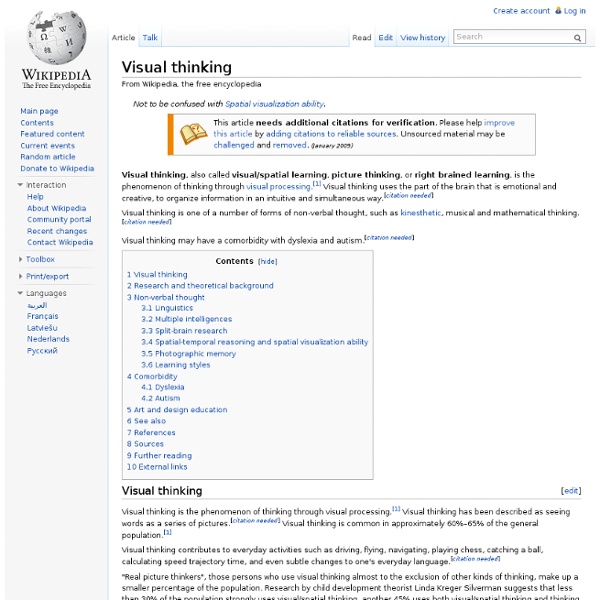The Learning Styles Myth
Subliminal learning is only one popular aid to learning that is a waste of money. Unfortunately education and learning are beset with fads, many based on inadequate research. These educational fads pop up like mushrooms after rain; one such fad is learning styles. Learning styles are supposedly the different approaches that different people have to learning. Learning style theorists believe that each of us favors some particular method of interacting with, and processing information. Proponents of learning styles claim that tailoring instruction to students' learning styles will allow students to learn more effectively. [1] One of the most widely-used models of learning styles is Fleming's VARK model which derived from Neuro-linguistic programming (NLP).[2] According to Fleming's model, which is relatively simple, learners can be categorized as follows: 1. 2. 3. 4. Fleming claimed that visual learners think in terms of pictures. There are many macro critiques of learning-style theories.
Procédure d'entreprise
Un article de Wikipédia, l'encyclopédie libre. Une procédure est la manière spécifiée d'effectuer une activité ou un processus (ISO/DIS 9000). Elle représente la manière de mettre en œuvre tout ou partie d'un processus et est reproductible. Ainsi, pour un processus donné peuvent correspondre plusieurs procédures : la chaîne d'activités est identique, mais les ressources (applicatives, humaines...) utilisées pour son exécution peuvent varier (par exemple, d'une filiale à l'autre, ou d'une direction à l'autre). La procédure ne doit pas être confondue avec le mode opératoire qui décrit la manière d'effectuer une des tâches spécifiée dans la procédure. Définition [1][modifier | modifier le code] « Une procédure d’entreprise est une procédure qui systématise l’organisation et la politique d’une entreprise dans le but d’atteindre certains des objectifs de cette entreprise. » Exemples de procédures d'entreprise[modifier | modifier le code] Exemple d'application[modifier | modifier le code]
Will Project - A Program of Research on the Will and Its Applications
HORARIO AEROPUERTOS
["aerol\u00ednea","aeropuerto","arte","avi\u00f3n","blanco","ciudad","clip","conmutaje","dato","destino","estacion","gr\u00e1fico","hojas","horario","iconos","ilustraci\u00f3n","im\u00e1genes predise\u00f1adas","informaci\u00f3n","informes","londres","mensaje","mesa","negro","nuevo","paris","roma","salida","signo","sobre","s\u00eddney","tabla","tabl\u00f3n de anuncios","texto","tiempo","tokio","tren","vector","viajar","vuelo","york","\u00f3mnibus"] aerolínea aeropuerto arte avión blanco ciudad clip conmutaje dato destino estacion gráfico hojas horario iconos ilustración imágenes prediseñadas información informes londres mensaje mesa negro nuevo paris roma salida signo sobre sídney tabla tablón de anuncios texto tiempo tokio tren vector viajar vuelo york ómnibus Ver todas las palabras clave
"Ces méthodes ont permis de faire progresser les
Vizthink Rennes - BUG
Un nouveau jalon a été délicatement déposé sur le chemin très fréquenté de l’innovation sociale à Rennes lors de l’apéruche de jeudi dernier. Non pas consacré à l’open data (autre événement TIC pachydermique de cette rentrée), mais à la visualisation des connaissances et aux méthodes qui s’y rapportent. Philippe Mac Clenahan, consultant de profession, a exposé les fondamentaux de la « doctrine » vizthink fondée sur l’approche visuelle de la pensée et de la créativité. Initiée par des fondateurs américains (David Sibbet, voir notamment « Visual Meetings »), cette communauté est un assemblage cohérent d’approches graphiques, méthodologiques d’origine variées visant au même but : mieux comprendre, mieux concevoir par une participation plus active des citoyens / salariés basée sur une approche visuelle des données et des connaissances. Quelques photos : www.jardin-des-savoirs.fr Démo jardin des savoirs Septembre 2010 from bug on Vimeo. Richard De Logu / @mediatino
Humanistic psychology
Humanistic psychology is a psychological perspective which rose to prominence in the mid-20th century in response to the limitations of Sigmund Freud's psychoanalytic theory and B.F. Skinner's behaviorism.[1] With its roots running from Socrates through the Renaissance, this approach emphasizes individuals inherent drive towards self-actualization and creativity. It typically holds that people are inherently good. It adopts a holistic approach to human existence and pays special attention to such phenomena as creativity, free will, and human potential. In the 20th century humanistic psychology was referred to as the "third force" in psychology, distinct from earlier, even less humanistic approaches of psychoanalysis and behaviorism. Its principal professional organizations in the U.S. are the Association for Humanistic Psychology and the Society for Humanistic Psychology (Division 32 of the American Psychological Association). Origins[edit] Conceptual origins[edit] Practical origins[edit]
The Power of Images: Visual-Spatial Learners
Educational articles are an excellent resource for parents who are interested in learning about the best parenting practices from experts in the field. With insights from top education specialists, these parenting articles provide advice and information for both typical and unusual parenting circumstances. A large range of topics are covered in these educational articles, from back-talking toddlers to college-bound teenagers. There are also articles about best practices to use with kids and teens with specific mental and physical needs. These parenting articles are great for anyone who wants to raise a healthy, happy child. Popular Articles See All Articles Email
Thinking Visually
Human Potential Movement
The Human Potential Movement (HPM) arose out of the milieu of the 1960s and formed around the concept of cultivating extraordinary potential that its advocates believed to lie largely untapped in all people. The movement took as its premise the belief that through the development of "human potential", humans can experience an exceptional quality of life filled with happiness, creativity, and fulfillment. As a corollary, those who begin to unleash this assumed potential often find themselves directing their actions within society towards assisting others to release their potential. Adherents believe that the net effect of individuals cultivating their potential will bring about positive social change at large. Roots[edit] The movement has its conceptual roots in existentialism and humanism. In the middle of the 1960s, George Leonard did research across the United States on the subject of human potential for the magazine, Look. Authors and essayists[edit] Notable proponents[edit] Notes[edit]



